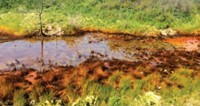Advertisement
Grab your lab coat. Let's get started
Welcome!
Welcome!
Create an account below to get 6 C&EN articles per month, receive newsletters and more - all free.
It seems this is your first time logging in online. Please enter the following information to continue.
As an ACS member you automatically get access to this site. All we need is few more details to create your reading experience.
Not you? Sign in with a different account.
Not you? Sign in with a different account.
ERROR 1
ERROR 1
ERROR 2
ERROR 2
ERROR 2
ERROR 2
ERROR 2
Password and Confirm password must match.
If you have an ACS member number, please enter it here so we can link this account to your membership. (optional)
ERROR 2
ACS values your privacy. By submitting your information, you are gaining access to C&EN and subscribing to our weekly newsletter. We use the information you provide to make your reading experience better, and we will never sell your data to third party members.
Environment
Toxic chemicals from fracking wastewater spills can persist for years
North Dakota fracking boom leaves residues of radium, selenium, lead, and other contaminants in the environment
by Deirdre Lockwood, special to C&EN
May 26, 2016
| A version of this story appeared in
Volume 94, Issue 22

In North Dakota’s Bakken region, a boom of hydraulic fracturing, or fracking, has generated nearly 10,000 wells for unconventional oil and gas production. This increased production also has resulted in almost 4,000 reported spills of fracking wastewater.
According to a new study, these spills have left soil and surface water in the area contaminated with water carrying radium, selenium, thallium, lead, and other toxic chemicals that can persist for years at unsafe levels (Environ. Sci. Technol. 2016, DOI: 10.1021/acs.est.5b06349).
Using fracking in oil and gas production brings up a brine that carries naturally occurring toxic or radioactive elements such as radium and selenium from rock formations. To understand the impact of fracking wastewater spills on the environment, Avner Vengosh of Duke University and his colleagues sampled water, sediment, and soil at sites of reported brine spills, which had occurred months to years earlier. To trace the source of contaminants at those sites, they also analyzed wastewater from shale gas wells in North Dakota and combined it with government data on fracking wastewater.
The ratio of strontium-87 to strontium-86 in fracking wastewater carries a distinctive signature of the rock formation where it was produced. By measuring strontium isotopes in the water produced by fracking wells and in water samples taken from spill sites, the researchers could identify brine residue from a spill. At confirmed spill sites, radium, selenium, and thallium exceeded maximum contaminant levels for drinking water in some water samples, and ammonium and selenium concentrations were above recommended levels for aquatic life. In soil and sediment samples downstream from the largest spill site, radium concentrations were up to 100 times as great as concentrations in samples upstream.
Brian W. Stewart, a geochemist at the University of Pittsburgh who studies fracking wastewater, says this is the first time, to his knowledge, that systematic sampling has been done downstream of known brine spills to detect the impact of wastewater from fracking. “I was surprised that it persists that long,” he says, pointing to two cases in which the group found elevated levels of contaminants four years after a spill.





Join the conversation
Contact the reporter
Submit a Letter to the Editor for publication
Engage with us on Twitter